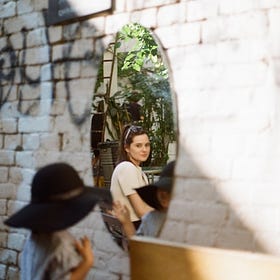After unearthing one of my core beliefs that I had unknowingly carried all this time, it felt like an ‘aha’ moment.
It was something I had always known but never truly acknowledged. It lived in the background, quietly shaping my choices, until I finally realized what it was.
It was the gap between my version of who I thought I was and reality.
Now that I know this, I can catch those moments when my autopilot takes over, when my core belief activates without me even noticing. And in those moments, I have the power to pause, to step back into conscious living, to choose my response—and therefore, the outcome.
“Between stimulus and response lies a space. In that space lies our freedom and power to choose a response. In our response lies our growth and our happiness.” - Viktor Frankl
Catching it is easier once you know it’s there. Choosing differently is harder. The old patterns—the childhood routines—feel comfortable. They offer certainty.
But between your old belief and its opposite lies a space. A space where freedom lives. A space where you can choose to walk a different path.
At first, forging that new path feels like hacking through a jungle—uncertain, uncomfortable, full of unknowns.
It’s hard to forge new paths. But it’s not impossible. And it can be freeing. And it’s worth it.

Here's what we are going to do
Before we begin, I encourage you to read my essay on core beliefs first. It shares the background on how core beliefs are formed, how they shape us, why uncovering them is essential, and my personal experience with it.
We’ll try to identify our core beliefs. Sometimes they surface easily; other times, it takes a bit of patience.
Either way, give yourself time and be kind to yourself. Every experience is different. These guiding questions can help you reconnect with your younger self.
⚡ Important: Revisiting childhood memories can be a triggering experience. If you’re not ready, you may want to skip this practice.
A few questions to ask yourself
As a child:
What were you praised for?
What were you reprimanded for?
What expectations did you connect those experiences to?
What strategies to react to those expectations?
What strategies are you still using today?
Whatever you find, meet it with compassion. Greet your core beliefs as an old friend. They have, after all, brought you to where you are today.
For those who want to go further
We shall work further with the core beliefs that we have unearthed and learn how to manage them.
Ask yourself:
What core beliefs still serve me today?
Which ones push me forward—or pressure me?
Which ones limit me?
Which ones create a sense that I—or others—am not enough?
Then, choose one limiting core belief to work on first. We will determine its opposite to create new possibilities for action.
“When you write it or speak it out, it should make you squirm. And if you're lucky, you might stumble upon a Sehnsucht feeling—a longing for something that gives you angst, but you kind of wish you had it or even wanted it.” - The parts of me I did not choose.
Ask yourself:
How can I formulate an opposite belief that pulls me in a completely different direction?
What words does this new belief need to have a lasting impact on me?
How does this opposite belief feel? Does it stir something in me, or do I need to intensify it further?
Finally, visualize yourself with the opposite. That’s it. Just let it do its magic.
What I did with the practice
When I worked through this practice myself, I uncovered a core belief I shared—I am strong and must protect my freedom at all costs.
It was limiting for me because I find it difficult to ask for help or be vulnerable, and I'm also hesitant to commit myself to anything that may restrict my freedom.
Working with its opposite not only scares me, but it also uncovers a Sehsucht in me—the longing to not be in control, to just be, and to let others help me.
Share with us
If you’ve uncovered a core belief—especially a limiting one—feel free to share it.
And if you’ve explored its opposite, I’d love to hear what effect that had on you, too.
Observe self
We will observe ourselves—only to observe, recognize it as it is, acknowledge it, and then let it go. This activity is inspired by Thich Nhat Hanh’s The Miracle of Mindfulness.






That Frankl quote hits hard, Rachel. The "space" between stimulus and response. In my world... we usually call that latency. And we try to eliminate it. But you're arguing for adding latency. A manual override to stop the autopilot.
You talk about "hacking through a jungle" to change the path. That is visceral. It feels like trying to rewrite the firmware while the machine is still running at max RPM. Most people just let the legacy code run because it's safer. It offers certainty.
But here is the thing... You mentioned a longing to let go of control. To let others help. In my novel... the protagonist takes total control because the external systems failed. He becomes the single point of failure. So I'm wondering... when you finally hack that new path and drop the defenses... does the system actually stabilize? Or do you find out those walls were load-bearing?
The first episode is live here... https://silentwitnessin.substack.com/p/file-001-the-thermodynamic-bluff?r=6r3orq
(My new serialized novel, The Man Who Blocked The Sun, follows a diabetic engineer who hacks the climate because the treaties are too slow. It'd mean the world to me if you'd join to follow the work.)
Oof the core belief you mentioned here may well be one of mine. I feel like I need to always present strength, so I too struggle to ask for help. I have much to work through, but your post was beautiful to read, as always <3